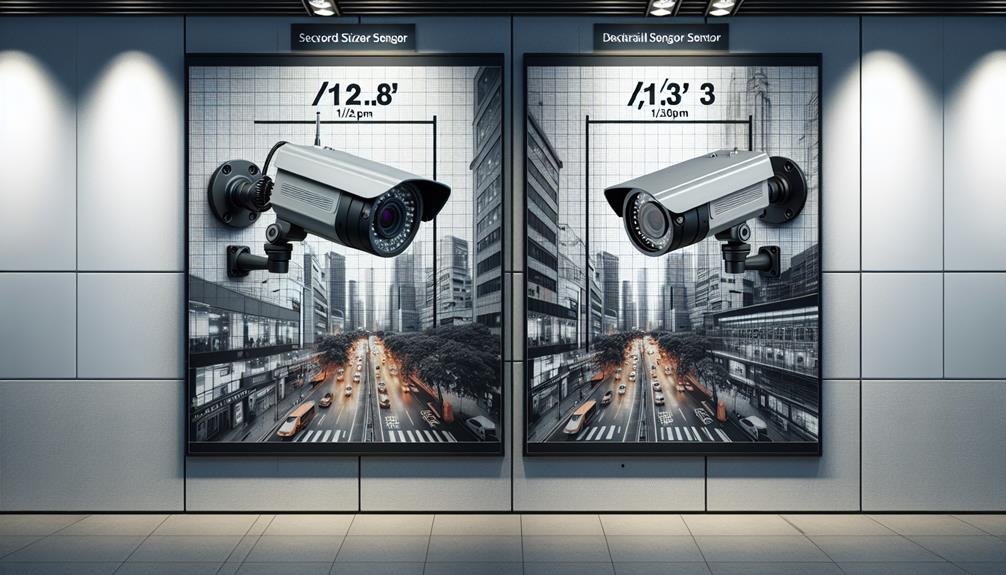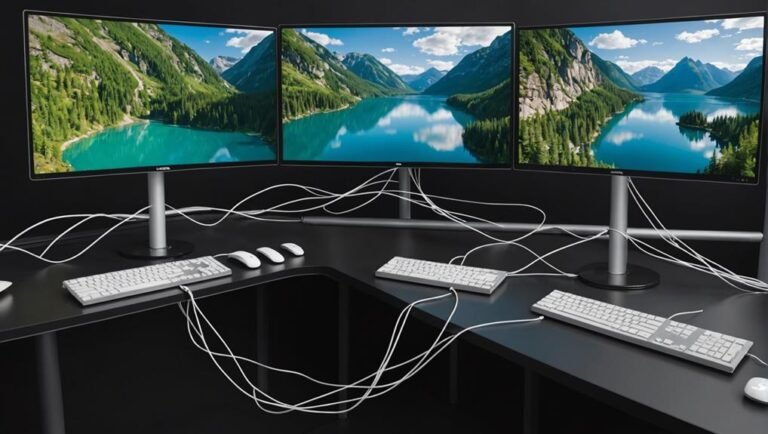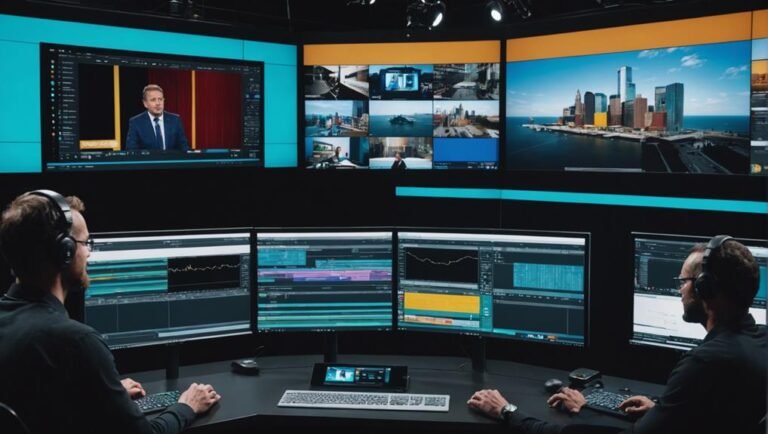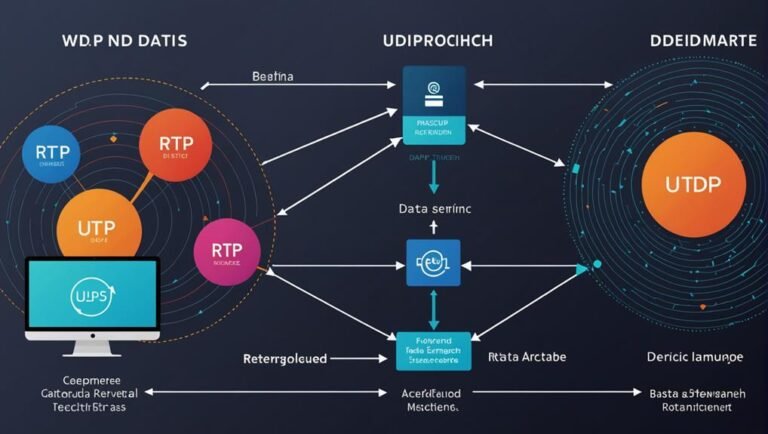When choosing between a 1/3 sensor and a 1/2.8 sensor for your CCTV system, the 1/2.8 sensor stands out. It captures more light, providing superior image quality, especially in low-light conditions. You’ll notice clearer, sharper images with better color accuracy. The 1/2.8 sensor also offers a wider field of view, reducing blind spots. It’s perfect for monitoring larger areas and ensuring every detail is captured, even in dimly lit environments. While the 1/3 sensor may be more cost-effective, the 1/2.8 sensor’s advantages in performance make it worth considering for high-quality surveillance. Curious to know more?
Sensor Size Comparison
When comparing a 1/3 sensor to a 1/2.8 sensor, you’ll notice that the latter is slightly larger in size. It’s an important difference that can greatly impact your CCTV setup. A larger sensor means more room for capturing light, which is essential for those who crave the freedom of clear and reliable footage, especially in varying light conditions. With a 1/2.8 sensor, you’re not constrained by the limitations smaller sensors impose.
Choosing a larger sensor like the 1/2.8 can also mean better performance in low-light scenarios. This means you won’t have to worry as much about grainy or unclear images when the sun sets. Instead, you’ll enjoy more consistent and dependable video quality around the clock. This gives you the freedom to monitor your property without being tied down by technical limitations.
Additionally, larger sensors often offer more advanced features and better compatibility with a range of lenses. This flexibility lets you customize your CCTV system to meet your specific needs, whether it’s for home security or a more extensive surveillance network. You don’t have to settle; you can opt for what truly serves your purpose.
Image Quality
You’ll notice a significant improvement in image quality with a 1/2.8 sensor compared to a 1/3 sensor. The larger sensor size allows for better capture of detail, giving you sharper and clearer images. This means you can identify faces, license plates, and other critical details with ease, offering you the freedom to feel more secure in your environment.
With a 1/2.8 sensor, the higher pixel count guarantees that images don’t distort or blur, even when you zoom in. You’ll appreciate the crispness and clarity that a smaller sensor just can’t provide. This can be particularly liberating if you need to monitor large or complex areas, where every detail counts.
Moreover, color reproduction is generally more accurate with a 1/2.8 sensor. You’ll get richer, more vibrant images, making it easier to discern different elements in the frame. This sensor excels in a variety of lighting conditions, making sure that your footage maintains high quality throughout the day.
Low Light Performance
In low light conditions, a 1/2.8 sensor far surpasses a 1/3 sensor, capturing clearer and more detailed images. When the sun goes down, you need to trust that your CCTV system can still provide quality footage. A 1/2.8 sensor excels in these situations by allowing more light to hit each pixel, improving visibility and reducing noise. This means you get sharper, more defined images even when lighting is less than ideal.
Imagine walking freely, knowing your security system won’t miss a thing, even in dimly lit areas. With a 1/2.8 sensor, you gain the confidence that your property is well-monitored, no matter the time of day. These sensors perform exceptionally well in various low-light environments, from dark alleys to poorly lit parking lots.
You don’t need to feel constrained by poor lighting anymore. The advanced technology in a 1/2.8 sensor guarantees that every detail is captured, providing reliable surveillance. So, if you’re seeking freedom from the limitations of inadequate lighting, investing in a CCTV system with a 1/2.8 sensor is the way to go. It’s about reclaiming your peace of mind and ensuring your security system is always up to the task.
Resolution Differences
Comparing resolution differences between a 1/3 sensor and a 1/2.8 sensor reveals significant impacts on image clarity and detail. You’ll notice that a 1/2.8 sensor generally offers higher resolution, allowing you to capture finer details in your CCTV footage. This means you can clearly identify faces, license plates, and other vital elements. It’s like upgrading from a standard TV to an HD display—everything just looks sharper.
When you’re choosing a CCTV system, you don’t want to compromise on image quality. A 1/2.8 sensor provides more pixels per inch, translating to better overall sharpness. This can be a game-changer for security, giving you the confidence that you’ll catch even the smallest details. It’s about having the freedom to see more and miss less, ensuring your peace of mind.
On the flip side, a 1/3 sensor might be more budget-friendly, but it usually comes with lower resolution. This could make a significant difference if you’re trying to identify a suspect or read a license plate. So, if high resolution is a priority for you, opting for the 1/2.8 sensor is the way to go.
Field of View
A 1/2.8 sensor typically offers a wider field of view compared to a 1/3 sensor, allowing you to monitor larger areas with a single camera. If you’re someone who values a broader perspective without the hassle of installing multiple cameras, this is a significant advantage. You’ll cover more ground, which means fewer blind spots and a better overall security experience.
Imagine having the freedom to see more of your property with just one camera. Whether it’s your home, office, or any other space, a wider field of view means you increase your surveillance efficiency. This can be particularly useful for large outdoor areas, parking lots, or expansive interior spaces where every inch matters. You won’t need to worry about missing critical angles or having to invest in additional equipment to cover what should be a single camera’s job.
Also, a wider field of view can simplify your surveillance setup, making it easier to manage and maintain. You’ll enjoy the benefits of extensive coverage without the need for complex installations or multiple camera feeds. This simplicity not only saves you time but also reduces potential points of failure, making your security system more reliable.
Noise Levels
When evaluating the advantages of a wider field of view, it’s also important to take into account the noise levels that different sensor sizes produce in low-light conditions. You’ll find that a 1/2.8 sensor typically has an edge over a 1/3 sensor when it comes to noise levels. This means clearer, more detailed images when the lighting isn’t ideal. It’s especially significant if you’re looking to maintain high-quality footage around the clock.
The larger 1/2.8 sensor can capture more light, reducing the noise that often plagues smaller sensors. You’ll get less grainy footage, which is essential for identifying crucial details. Think about it: in a security scenario, every detail counts. The ability to clearly see faces or license plates can make a significant impact.
Furthermore, you won’t have to worry as much about image distortion due to noise, which can obscure important details. A 1/2.8 sensor will give you the freedom to review footage confidently, knowing that the quality won’t be compromised by poor lighting conditions. When freedom means having reliable, clear evidence, opting for a sensor with better noise performance is an obvious choice.
Cost Considerations
Investing in a 1/2.8 sensor might initially cost more, but the long-term benefits often outweigh the higher price tag. When you’re looking for quality and reliability in your CCTV system, it’s important to take into account what you’re really paying for. The higher upfront cost of a 1/2.8 sensor often translates to superior image quality, especially in low-light conditions. This means you’ll get clearer, more detailed footage, which can be important for security purposes.
Think about the potential costs of poor-quality footage. If your 1/3 sensor fails to capture vital details, you might face higher risks and potential losses. A 1/2.8 sensor, despite its higher price, reduces such risks significantly. You won’t have to worry about upgrading your system frequently, saving you money in the long run.
Additionally, 1/2.8 sensors often come with better warranties and customer support. This means less downtime and more reliable service. You get peace of mind knowing that your investment is protected. While the initial sticker shock might make you hesitate, consider the broader picture. You’re not just buying a sensor; you’re investing in a more secure environment. In the end, the freedom from worry and the assurance of high-quality footage are worth the extra cost.
Best Use Cases
Opting for a 1/2.8 sensor is ideal for environments requiring high-quality footage in low-light conditions. If you’re managing a nightclub or a dimly lit restaurant, this sensor excels at capturing clear images without needing excessive lighting. You’ll appreciate its ability to provide detailed visuals, ensuring you don’t miss any essential moments, regardless of the lighting conditions.
For outdoor surveillance, especially in areas with inconsistent lighting like alleyways or parking lots, the 1/2.8 sensor proves invaluable. It adapts well to varying light levels, giving you the freedom to rely on your CCTV system no matter the time of day. Plus, you won’t need to invest in additional lighting, saving you both money and hassle.
On the other hand, a 1/3 sensor is a solid choice for environments where lighting is more controlled. Think offices, retail stores, or well-lit public spaces. It’s cost-effective and provides adequate image quality for day-to-day surveillance needs. You get to maintain security without breaking the bank, enjoying the peace of mind that comes with knowing your environment is monitored effectively.
Choose the sensor that aligns best with your specific needs, and you’ll have a CCTV system that truly supports your pursuit of freedom.
Frequently Asked Questions
How Does Sensor Size Impact the Camera’s Form Factor and Installation Options?
Imagine a camera as a bird; a larger sensor is like a bigger wingspan. It gives you more flexibility in capturing details but may limit where you can install it due to its size. Choose wisely!
Are There Significant Differences in Power Consumption Between the Two Sensor Types?
You’ll notice that different sensor types can impact power consumption. Typically, larger sensors might draw more power due to increased processing needs, but newer technology can offset this. Always check the specs for accurate details.
What Are the Maintenance Requirements for Each Sensor Size?
You’ll find that both sensor sizes require minimal maintenance. Regularly clean the lens and sensor, guarantee proper ventilation, and check for firmware updates. That way, you’ll keep your CCTV system running smoothly without much hassle.
Can Either Sensor Handle Extreme Weather Conditions Better?
You’ll find both sensors can handle extreme weather conditions, but the larger sensor might offer slightly better performance. Think of it like a hardy jalopy ready for any road. Freedom’s yours with either choice.
How Do These Sensor Sizes Affect the Camera’s Compatibility With Existing Systems?
Sensor sizes can affect compatibility with existing systems. Smaller sensors might fit more easily into your current setup, while larger ones could require adjustments. Always verify the specifications to guarantee everything works seamlessly together for ultimate freedom.



